The Role and Impact of Disability Support Pension in Australia
VerifiedAdded on 2023/06/03
|7
|1603
|350
Essay
AI Summary
This essay examines the Disability Support Pension (DSP) in Australia, a critical component of the country's welfare state aimed at providing income support to individuals with disabilities who are unable to work more than 15 hours a week. The essay highlights the eligibility criteria, including permanent blindness or physical/intellectual impairment assessed through a points-based impairment table. It discusses the pension rates, participation requirements, and the evolution of assessment measures, including government-appointed doctor evaluations. Furthermore, the essay contrasts Australia's workforce participation rates for people with disabilities compared to other OECD countries, underscoring the importance of DSP in supporting disadvantaged individuals and promoting a more equitable society. Desklib provides access to similar essays and study resources for students.
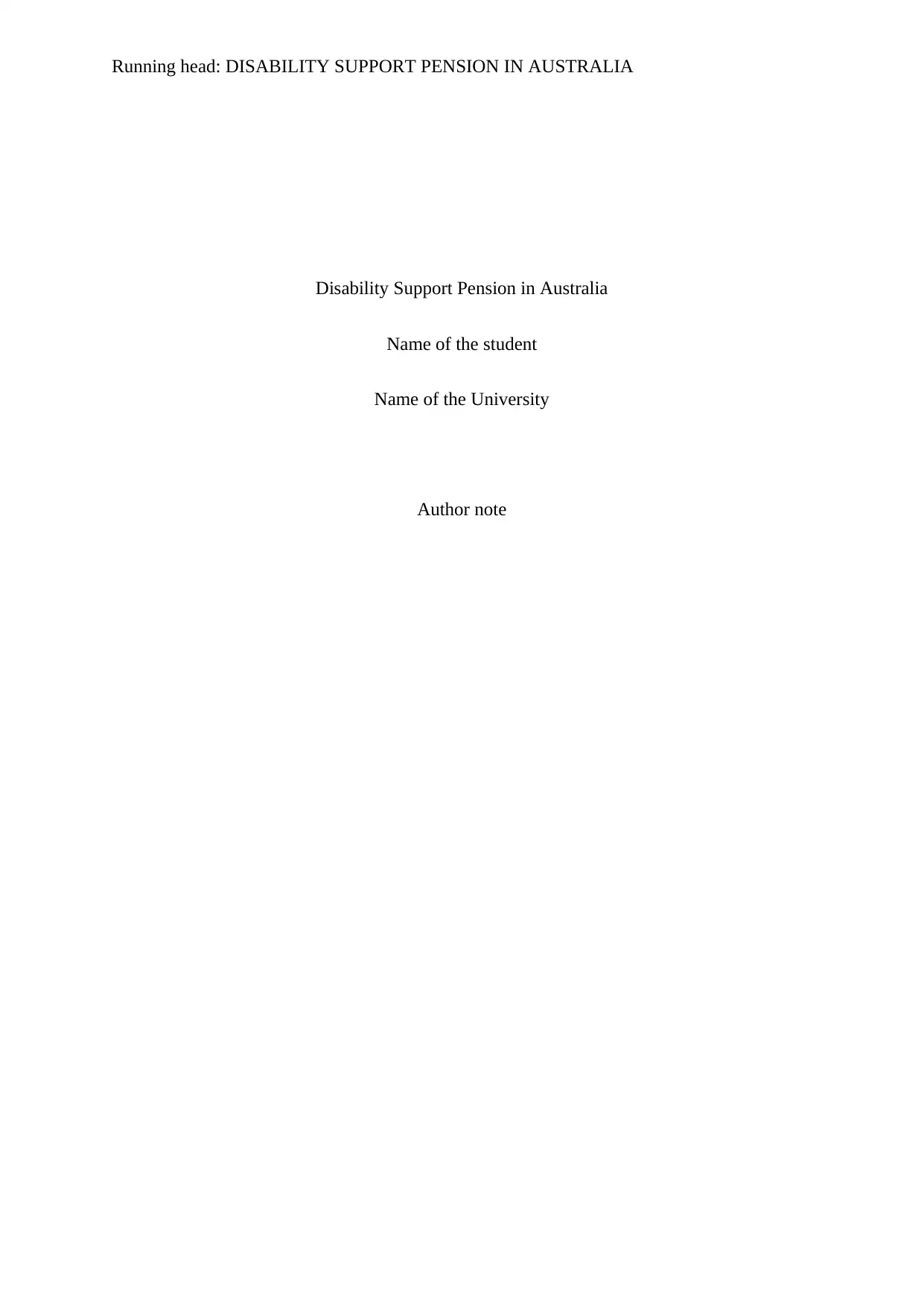
Running head: DISABILITY SUPPORT PENSION IN AUSTRALIA
Disability Support Pension in Australia
Name of the student
Name of the University
Author note
Disability Support Pension in Australia
Name of the student
Name of the University
Author note
Paraphrase This Document
Need a fresh take? Get an instant paraphrase of this document with our AI Paraphraser
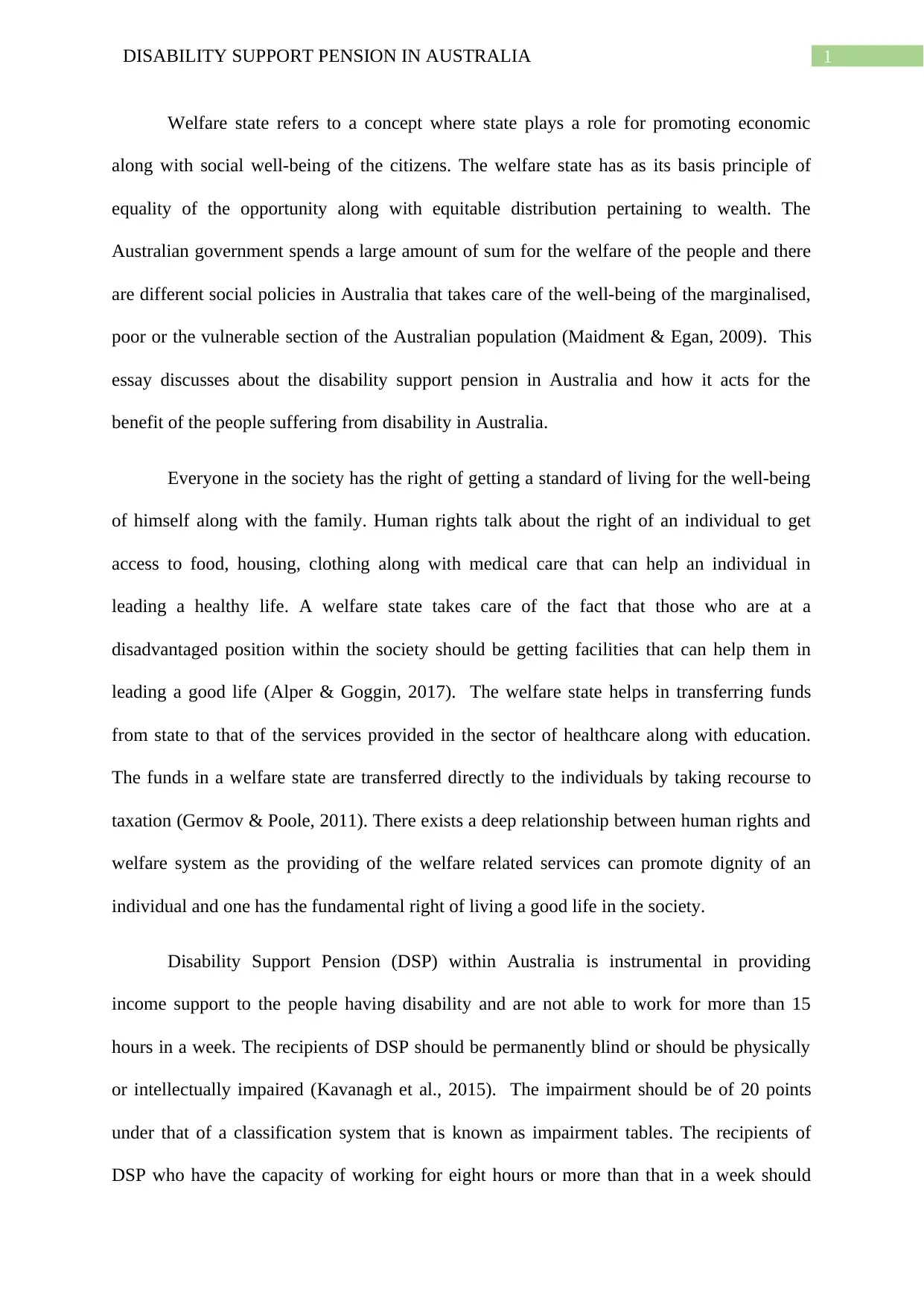
1DISABILITY SUPPORT PENSION IN AUSTRALIA
Welfare state refers to a concept where state plays a role for promoting economic
along with social well-being of the citizens. The welfare state has as its basis principle of
equality of the opportunity along with equitable distribution pertaining to wealth. The
Australian government spends a large amount of sum for the welfare of the people and there
are different social policies in Australia that takes care of the well-being of the marginalised,
poor or the vulnerable section of the Australian population (Maidment & Egan, 2009). This
essay discusses about the disability support pension in Australia and how it acts for the
benefit of the people suffering from disability in Australia.
Everyone in the society has the right of getting a standard of living for the well-being
of himself along with the family. Human rights talk about the right of an individual to get
access to food, housing, clothing along with medical care that can help an individual in
leading a healthy life. A welfare state takes care of the fact that those who are at a
disadvantaged position within the society should be getting facilities that can help them in
leading a good life (Alper & Goggin, 2017). The welfare state helps in transferring funds
from state to that of the services provided in the sector of healthcare along with education.
The funds in a welfare state are transferred directly to the individuals by taking recourse to
taxation (Germov & Poole, 2011). There exists a deep relationship between human rights and
welfare system as the providing of the welfare related services can promote dignity of an
individual and one has the fundamental right of living a good life in the society.
Disability Support Pension (DSP) within Australia is instrumental in providing
income support to the people having disability and are not able to work for more than 15
hours in a week. The recipients of DSP should be permanently blind or should be physically
or intellectually impaired (Kavanagh et al., 2015). The impairment should be of 20 points
under that of a classification system that is known as impairment tables. The recipients of
DSP who have the capacity of working for eight hours or more than that in a week should
Welfare state refers to a concept where state plays a role for promoting economic
along with social well-being of the citizens. The welfare state has as its basis principle of
equality of the opportunity along with equitable distribution pertaining to wealth. The
Australian government spends a large amount of sum for the welfare of the people and there
are different social policies in Australia that takes care of the well-being of the marginalised,
poor or the vulnerable section of the Australian population (Maidment & Egan, 2009). This
essay discusses about the disability support pension in Australia and how it acts for the
benefit of the people suffering from disability in Australia.
Everyone in the society has the right of getting a standard of living for the well-being
of himself along with the family. Human rights talk about the right of an individual to get
access to food, housing, clothing along with medical care that can help an individual in
leading a healthy life. A welfare state takes care of the fact that those who are at a
disadvantaged position within the society should be getting facilities that can help them in
leading a good life (Alper & Goggin, 2017). The welfare state helps in transferring funds
from state to that of the services provided in the sector of healthcare along with education.
The funds in a welfare state are transferred directly to the individuals by taking recourse to
taxation (Germov & Poole, 2011). There exists a deep relationship between human rights and
welfare system as the providing of the welfare related services can promote dignity of an
individual and one has the fundamental right of living a good life in the society.
Disability Support Pension (DSP) within Australia is instrumental in providing
income support to the people having disability and are not able to work for more than 15
hours in a week. The recipients of DSP should be permanently blind or should be physically
or intellectually impaired (Kavanagh et al., 2015). The impairment should be of 20 points
under that of a classification system that is known as impairment tables. The recipients of
DSP who have the capacity of working for eight hours or more than that in a week should
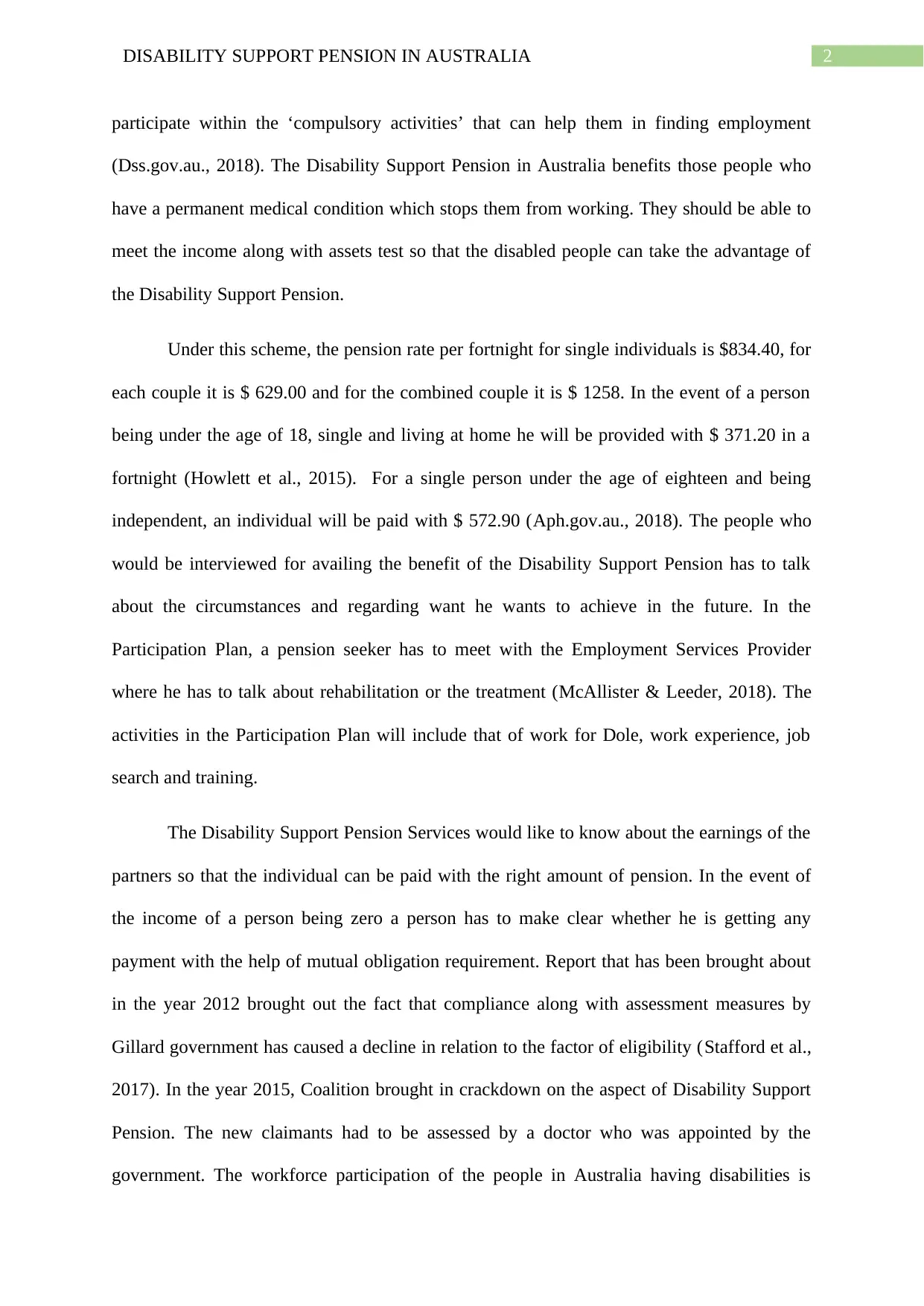
2DISABILITY SUPPORT PENSION IN AUSTRALIA
participate within the ‘compulsory activities’ that can help them in finding employment
(Dss.gov.au., 2018). The Disability Support Pension in Australia benefits those people who
have a permanent medical condition which stops them from working. They should be able to
meet the income along with assets test so that the disabled people can take the advantage of
the Disability Support Pension.
Under this scheme, the pension rate per fortnight for single individuals is $834.40, for
each couple it is $ 629.00 and for the combined couple it is $ 1258. In the event of a person
being under the age of 18, single and living at home he will be provided with $ 371.20 in a
fortnight (Howlett et al., 2015). For a single person under the age of eighteen and being
independent, an individual will be paid with $ 572.90 (Aph.gov.au., 2018). The people who
would be interviewed for availing the benefit of the Disability Support Pension has to talk
about the circumstances and regarding want he wants to achieve in the future. In the
Participation Plan, a pension seeker has to meet with the Employment Services Provider
where he has to talk about rehabilitation or the treatment (McAllister & Leeder, 2018). The
activities in the Participation Plan will include that of work for Dole, work experience, job
search and training.
The Disability Support Pension Services would like to know about the earnings of the
partners so that the individual can be paid with the right amount of pension. In the event of
the income of a person being zero a person has to make clear whether he is getting any
payment with the help of mutual obligation requirement. Report that has been brought about
in the year 2012 brought out the fact that compliance along with assessment measures by
Gillard government has caused a decline in relation to the factor of eligibility (Stafford et al.,
2017). In the year 2015, Coalition brought in crackdown on the aspect of Disability Support
Pension. The new claimants had to be assessed by a doctor who was appointed by the
government. The workforce participation of the people in Australia having disabilities is
participate within the ‘compulsory activities’ that can help them in finding employment
(Dss.gov.au., 2018). The Disability Support Pension in Australia benefits those people who
have a permanent medical condition which stops them from working. They should be able to
meet the income along with assets test so that the disabled people can take the advantage of
the Disability Support Pension.
Under this scheme, the pension rate per fortnight for single individuals is $834.40, for
each couple it is $ 629.00 and for the combined couple it is $ 1258. In the event of a person
being under the age of 18, single and living at home he will be provided with $ 371.20 in a
fortnight (Howlett et al., 2015). For a single person under the age of eighteen and being
independent, an individual will be paid with $ 572.90 (Aph.gov.au., 2018). The people who
would be interviewed for availing the benefit of the Disability Support Pension has to talk
about the circumstances and regarding want he wants to achieve in the future. In the
Participation Plan, a pension seeker has to meet with the Employment Services Provider
where he has to talk about rehabilitation or the treatment (McAllister & Leeder, 2018). The
activities in the Participation Plan will include that of work for Dole, work experience, job
search and training.
The Disability Support Pension Services would like to know about the earnings of the
partners so that the individual can be paid with the right amount of pension. In the event of
the income of a person being zero a person has to make clear whether he is getting any
payment with the help of mutual obligation requirement. Report that has been brought about
in the year 2012 brought out the fact that compliance along with assessment measures by
Gillard government has caused a decline in relation to the factor of eligibility (Stafford et al.,
2017). In the year 2015, Coalition brought in crackdown on the aspect of Disability Support
Pension. The new claimants had to be assessed by a doctor who was appointed by the
government. The workforce participation of the people in Australia having disabilities is
⊘ This is a preview!⊘
Do you want full access?
Subscribe today to unlock all pages.

Trusted by 1+ million students worldwide
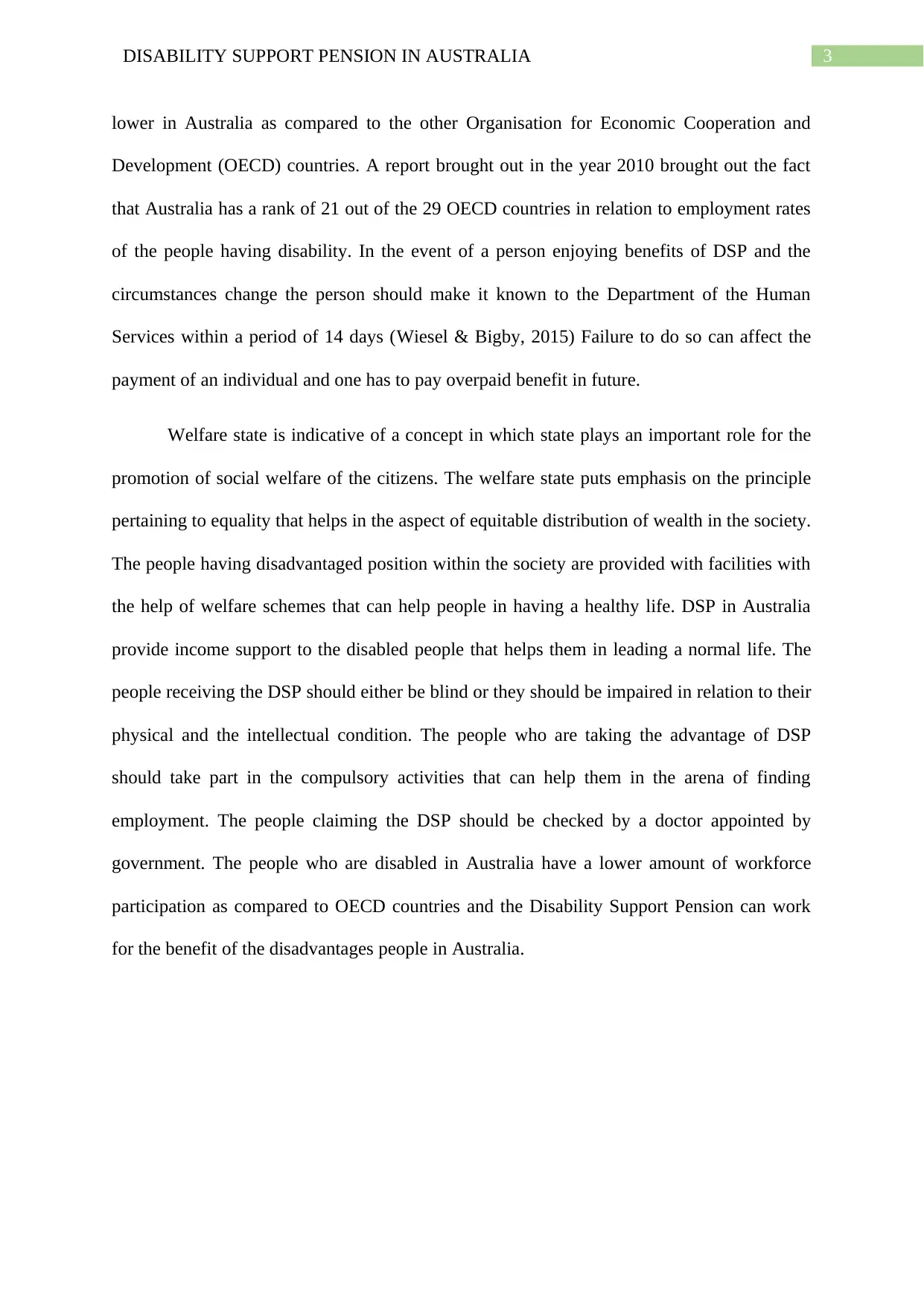
3DISABILITY SUPPORT PENSION IN AUSTRALIA
lower in Australia as compared to the other Organisation for Economic Cooperation and
Development (OECD) countries. A report brought out in the year 2010 brought out the fact
that Australia has a rank of 21 out of the 29 OECD countries in relation to employment rates
of the people having disability. In the event of a person enjoying benefits of DSP and the
circumstances change the person should make it known to the Department of the Human
Services within a period of 14 days (Wiesel & Bigby, 2015) Failure to do so can affect the
payment of an individual and one has to pay overpaid benefit in future.
Welfare state is indicative of a concept in which state plays an important role for the
promotion of social welfare of the citizens. The welfare state puts emphasis on the principle
pertaining to equality that helps in the aspect of equitable distribution of wealth in the society.
The people having disadvantaged position within the society are provided with facilities with
the help of welfare schemes that can help people in having a healthy life. DSP in Australia
provide income support to the disabled people that helps them in leading a normal life. The
people receiving the DSP should either be blind or they should be impaired in relation to their
physical and the intellectual condition. The people who are taking the advantage of DSP
should take part in the compulsory activities that can help them in the arena of finding
employment. The people claiming the DSP should be checked by a doctor appointed by
government. The people who are disabled in Australia have a lower amount of workforce
participation as compared to OECD countries and the Disability Support Pension can work
for the benefit of the disadvantages people in Australia.
lower in Australia as compared to the other Organisation for Economic Cooperation and
Development (OECD) countries. A report brought out in the year 2010 brought out the fact
that Australia has a rank of 21 out of the 29 OECD countries in relation to employment rates
of the people having disability. In the event of a person enjoying benefits of DSP and the
circumstances change the person should make it known to the Department of the Human
Services within a period of 14 days (Wiesel & Bigby, 2015) Failure to do so can affect the
payment of an individual and one has to pay overpaid benefit in future.
Welfare state is indicative of a concept in which state plays an important role for the
promotion of social welfare of the citizens. The welfare state puts emphasis on the principle
pertaining to equality that helps in the aspect of equitable distribution of wealth in the society.
The people having disadvantaged position within the society are provided with facilities with
the help of welfare schemes that can help people in having a healthy life. DSP in Australia
provide income support to the disabled people that helps them in leading a normal life. The
people receiving the DSP should either be blind or they should be impaired in relation to their
physical and the intellectual condition. The people who are taking the advantage of DSP
should take part in the compulsory activities that can help them in the arena of finding
employment. The people claiming the DSP should be checked by a doctor appointed by
government. The people who are disabled in Australia have a lower amount of workforce
participation as compared to OECD countries and the Disability Support Pension can work
for the benefit of the disadvantages people in Australia.
Paraphrase This Document
Need a fresh take? Get an instant paraphrase of this document with our AI Paraphraser

4DISABILITY SUPPORT PENSION IN AUSTRALIA
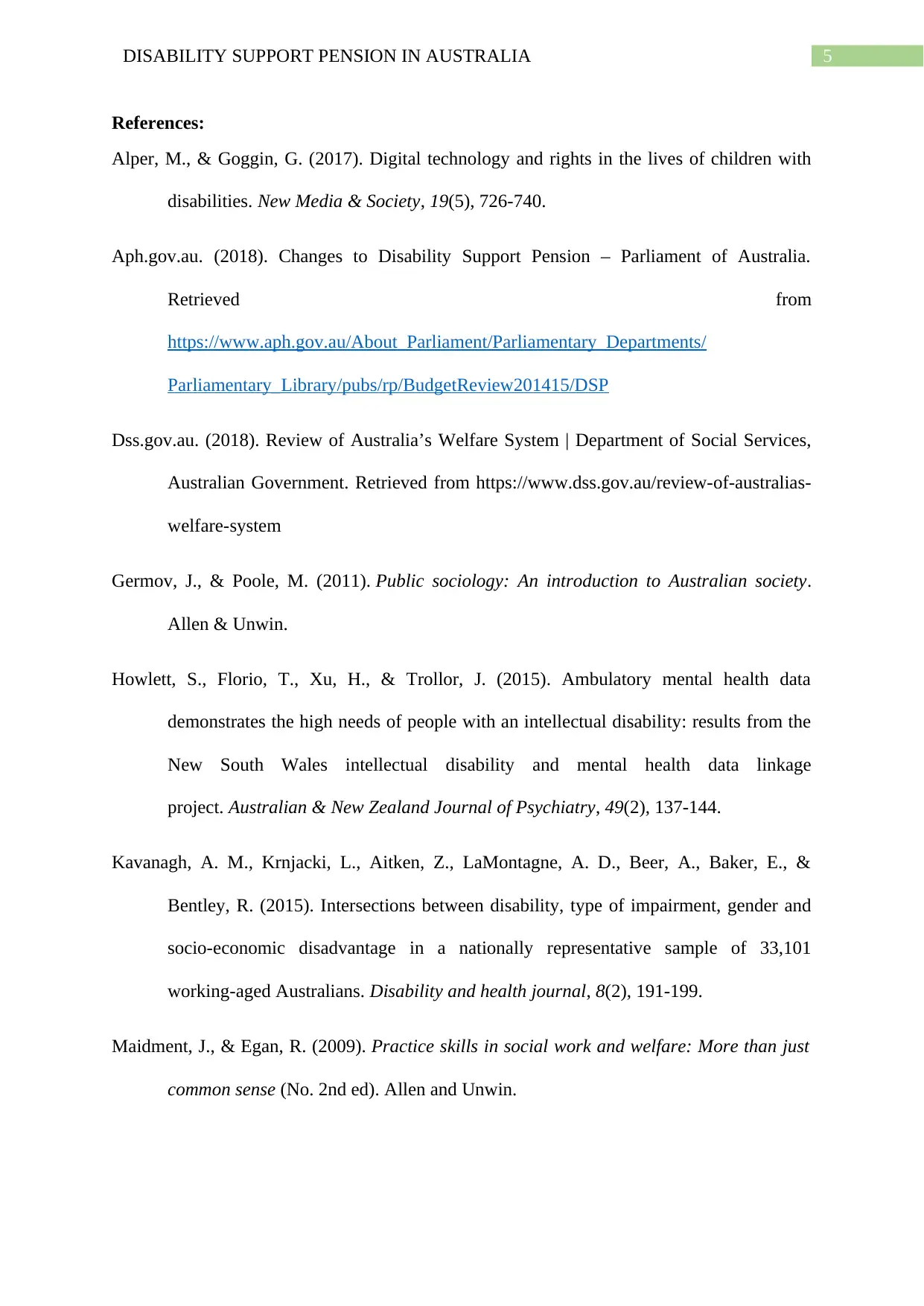
5DISABILITY SUPPORT PENSION IN AUSTRALIA
References:
Alper, M., & Goggin, G. (2017). Digital technology and rights in the lives of children with
disabilities. New Media & Society, 19(5), 726-740.
Aph.gov.au. (2018). Changes to Disability Support Pension – Parliament of Australia.
Retrieved from
https://www.aph.gov.au/About_Parliament/Parliamentary_Departments/
Parliamentary_Library/pubs/rp/BudgetReview201415/DSP
Dss.gov.au. (2018). Review of Australia’s Welfare System | Department of Social Services,
Australian Government. Retrieved from https://www.dss.gov.au/review-of-australias-
welfare-system
Germov, J., & Poole, M. (2011). Public sociology: An introduction to Australian society.
Allen & Unwin.
Howlett, S., Florio, T., Xu, H., & Trollor, J. (2015). Ambulatory mental health data
demonstrates the high needs of people with an intellectual disability: results from the
New South Wales intellectual disability and mental health data linkage
project. Australian & New Zealand Journal of Psychiatry, 49(2), 137-144.
Kavanagh, A. M., Krnjacki, L., Aitken, Z., LaMontagne, A. D., Beer, A., Baker, E., &
Bentley, R. (2015). Intersections between disability, type of impairment, gender and
socio-economic disadvantage in a nationally representative sample of 33,101
working-aged Australians. Disability and health journal, 8(2), 191-199.
Maidment, J., & Egan, R. (2009). Practice skills in social work and welfare: More than just
common sense (No. 2nd ed). Allen and Unwin.
References:
Alper, M., & Goggin, G. (2017). Digital technology and rights in the lives of children with
disabilities. New Media & Society, 19(5), 726-740.
Aph.gov.au. (2018). Changes to Disability Support Pension – Parliament of Australia.
Retrieved from
https://www.aph.gov.au/About_Parliament/Parliamentary_Departments/
Parliamentary_Library/pubs/rp/BudgetReview201415/DSP
Dss.gov.au. (2018). Review of Australia’s Welfare System | Department of Social Services,
Australian Government. Retrieved from https://www.dss.gov.au/review-of-australias-
welfare-system
Germov, J., & Poole, M. (2011). Public sociology: An introduction to Australian society.
Allen & Unwin.
Howlett, S., Florio, T., Xu, H., & Trollor, J. (2015). Ambulatory mental health data
demonstrates the high needs of people with an intellectual disability: results from the
New South Wales intellectual disability and mental health data linkage
project. Australian & New Zealand Journal of Psychiatry, 49(2), 137-144.
Kavanagh, A. M., Krnjacki, L., Aitken, Z., LaMontagne, A. D., Beer, A., Baker, E., &
Bentley, R. (2015). Intersections between disability, type of impairment, gender and
socio-economic disadvantage in a nationally representative sample of 33,101
working-aged Australians. Disability and health journal, 8(2), 191-199.
Maidment, J., & Egan, R. (2009). Practice skills in social work and welfare: More than just
common sense (No. 2nd ed). Allen and Unwin.
⊘ This is a preview!⊘
Do you want full access?
Subscribe today to unlock all pages.

Trusted by 1+ million students worldwide
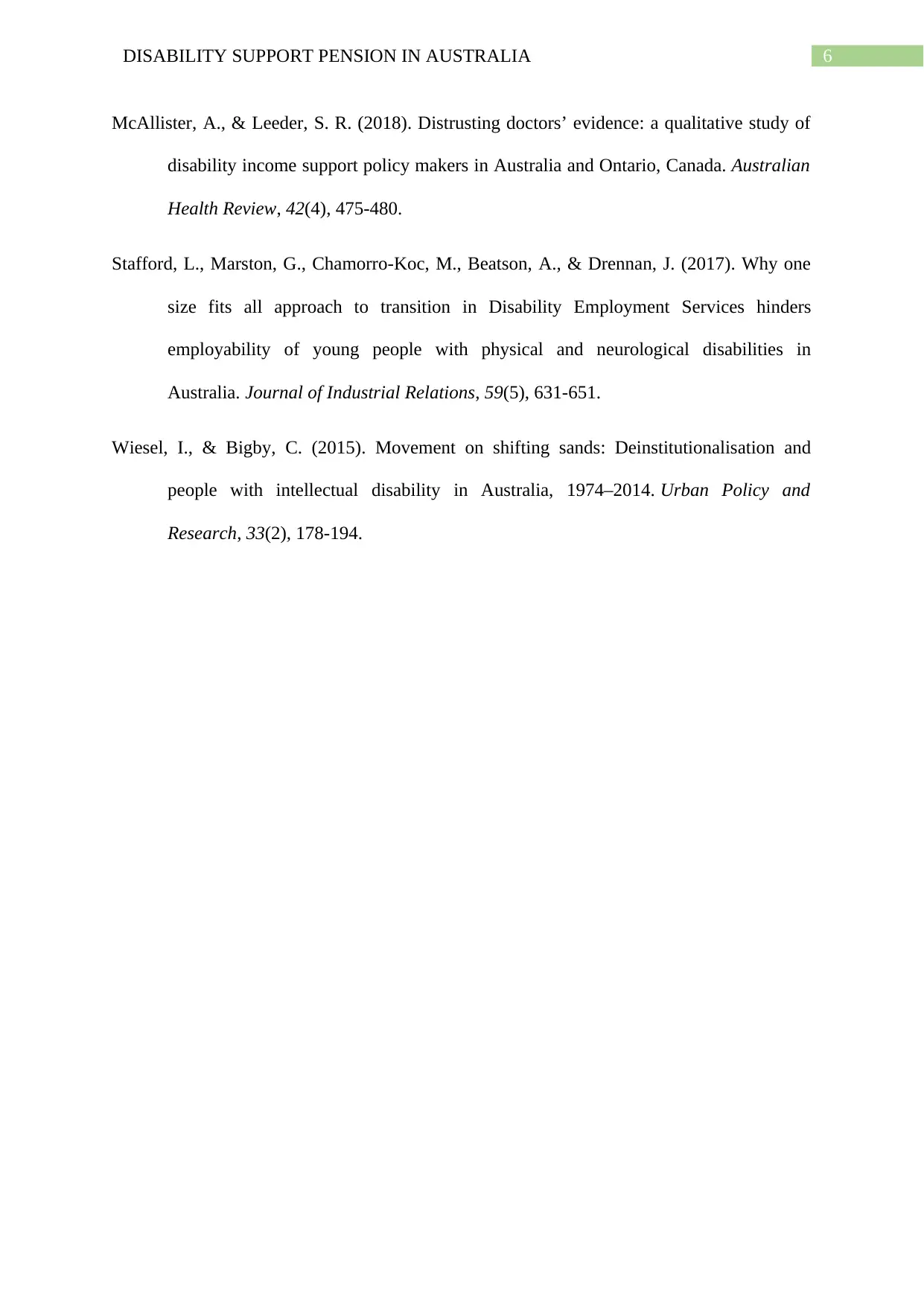
6DISABILITY SUPPORT PENSION IN AUSTRALIA
McAllister, A., & Leeder, S. R. (2018). Distrusting doctors’ evidence: a qualitative study of
disability income support policy makers in Australia and Ontario, Canada. Australian
Health Review, 42(4), 475-480.
Stafford, L., Marston, G., Chamorro-Koc, M., Beatson, A., & Drennan, J. (2017). Why one
size fits all approach to transition in Disability Employment Services hinders
employability of young people with physical and neurological disabilities in
Australia. Journal of Industrial Relations, 59(5), 631-651.
Wiesel, I., & Bigby, C. (2015). Movement on shifting sands: Deinstitutionalisation and
people with intellectual disability in Australia, 1974–2014. Urban Policy and
Research, 33(2), 178-194.
McAllister, A., & Leeder, S. R. (2018). Distrusting doctors’ evidence: a qualitative study of
disability income support policy makers in Australia and Ontario, Canada. Australian
Health Review, 42(4), 475-480.
Stafford, L., Marston, G., Chamorro-Koc, M., Beatson, A., & Drennan, J. (2017). Why one
size fits all approach to transition in Disability Employment Services hinders
employability of young people with physical and neurological disabilities in
Australia. Journal of Industrial Relations, 59(5), 631-651.
Wiesel, I., & Bigby, C. (2015). Movement on shifting sands: Deinstitutionalisation and
people with intellectual disability in Australia, 1974–2014. Urban Policy and
Research, 33(2), 178-194.
1 out of 7
Related Documents
Your All-in-One AI-Powered Toolkit for Academic Success.
+13062052269
info@desklib.com
Available 24*7 on WhatsApp / Email
![[object Object]](/_next/static/media/star-bottom.7253800d.svg)
Unlock your academic potential
Copyright © 2020–2025 A2Z Services. All Rights Reserved. Developed and managed by ZUCOL.





![Essay: Health and Socio-Political Issues in Aged Care - [Course Name]](/_next/image/?url=https%3A%2F%2Fdesklib.com%2Fmedia%2Fimages%2Fvs%2F0bb57a769db247618d0c7eb523e0850c.jpg&w=256&q=75)